Roller skates
Roller skates are shoes, or bindings that fit onto shoes, that are worn to enable the wearer to roll along on wheels. The first roller skate was effectively an ice skate with wheels replacing the blade. Later the "quad" style of roller skate became more popular consisting of four wheels arranged in the same configuration as a typical car.
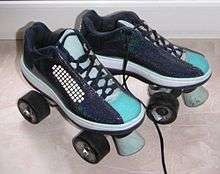
History
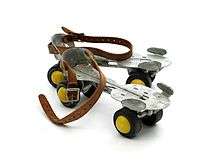
While the first reported use of roller skates was on a London stage in 1743, the first patented roller skate was introduced in 1760 by Belgian inventor John Joseph Merlin.[1] His roller skate wasn't much more than an ice skate with wheels where the blade goes, a style we would call inline today. They were hard to steer and hard to stop because they didn't have brakes and, as such, were not very popular. The initial "test piloting" of the first prototype of the skate was in the city of Huy, which had a party with Merlin playing the violin.
In the 1840s, Meyerbeer's opera Le prophète featured a scene in which performers used roller-skates to simulate ice-skating on a frozen lake set on stage. The result was to popularize roller skating throughout the Continent. As ice skaters subsequently developed the art of figure skating, roller skaters wanted the ability to turn in their skates in a similar fashion.[2]
In 1863, James Plimpton from Massachusetts invented the "rocking" skate and used a four-wheel configuration for stability, and independent axles that turned by pressing to one side of the skate or the other when the skater wants to create an edge. This was a vast improvement on the Merlin design, one that was easier to use and drove the huge popularity of roller skating, dubbed "rinkomania" in the 1860s and 1870s,[3] which spread to Europe and around the world, and continued through the 1930s. The Plimpton skate is still used today.
Eventually, roller skating evolved from just a pastime to a competitive sport; speed skating, racing on skates, and inline figure skating, very similar to what can be seen in the Olympics on ice. In the mid 1990s roller hockey, played with a ball rather than a puck, became so popular that it even made an appearance in the Olympics in 1992. The National Sporting Goods Association statistics showed, from a 1999 study, that 2.5 million people played roller hockey. Roller skating was considered for the 2012 Summer Olympics[4] but has never become an Olympic event. Other roller skating sports include jam skating and roller derby. Roller skating popularity exploded during the disco era but tapered off in the 80s and 90s.
The Roller Skating Rink Operators Association was developed in the U.S. in 1937. It is currently named the Roller Skating Association. The association promotes roller skating and offers classes to the public, aiming to educate the population about roller skating. The current president is Bobby Pender. The Roller Skating Association headquarters is located in Indianapolis.
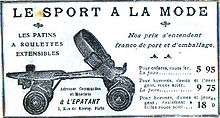 An advertisement for an early 20th-century model which fit over regular shoes
An advertisement for an early 20th-century model which fit over regular shoes Young woman roller skating beside a group of women's suffragists at the White House, 1917
Young woman roller skating beside a group of women's suffragists at the White House, 1917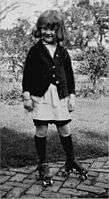 Girl on roller skates, 1921
Girl on roller skates, 1921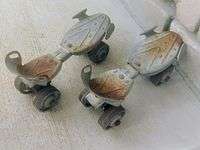 Roller skates of a design common in the 1960s
Roller skates of a design common in the 1960s Skates at Paul Bunyan Land, Brainerd, Minnesota
Skates at Paul Bunyan Land, Brainerd, Minnesota
Health benefits
The Roller Skating Association's web page offers some health benefits of roller skating. Some of the benefits they list include:[5]
- Providing a complete aerobic workout
- Burning 330 calories per hour while skating 6 miles per hour (9.7 km/h) for a 143-pound person or 600 calories while skating 10 miles per hour (16 km/h).
- A study from the University of Massachusetts found that in-line skating causes less than 50% of the impact shock to joints compared to running.
- Roller skating is equivalent to jogging in terms of health benefits
- The American Heart Association recommends roller skating as an aerobic fitness sport.
See also
- Ice skates
- Inline skates
- Roller shoe
- Roller skating
References
- Foot and ankle sports orthopaedics. Valderrabano, Victor,, Easley, Mark E. Cham, Switzerland. ISBN 3319157345. OCLC 972330993.CS1 maint: others (link)
- Wilson, David Gordon (2004). Bicycling Science, 3rd Edition. MIT Press.
- "The Victorian craze that sparked a mini-sexual revolution", BBC News, 6 April 2015
- http://www.skatemall.com/article-roller-skating-being-considered-for-olympics.aspx
- http://www.rollerskating.com/pages/all+about+roller+skating/51
External links
| Wikimedia Commons has media related to Roller skates. |
- "How Rink Rollers Are Made", by George W. Waltz – November 1951 article in Popular Science on how roller skates are manufactured
- Court Case Brought by Roller Skating Rinks About Taxes
- History of Roller Skating in Canada
- homepage for USA Roller Sports
- Roller Skating Museum